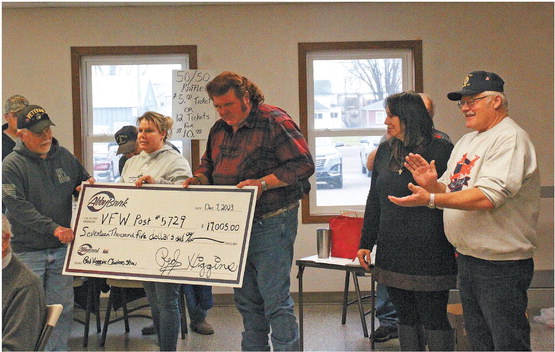Clark County mill rate expected to decrease in 2024
Tribune Record Gleaner County taxpayers should see some savings on their tax bill in December, at least on the portion of taxes directed to the county. According to the proposed budget brought before the county board Oct. 10, the county tax rate is expected to decline slightly this year, going from $7.53 in tax per $1,000 of property value to $7.14. That would result in a decrease of $38.75 in property tax on a $100,000 home.
In 2024, the county plans to again utilize short-term borrowing to supplement its levy income in order to pay for repaving county roads. The county has utilized this strategy for the past nine years, as otherwise it would not have enough money to keep up with road construction. The county cannot simply raise the tax rate to cover road construction, as the state sets strict limitations on how much the levy can be raised.
The levy limits imposed by the state do not allow the county to increase the base levy above the allowed percentage. The percentage allowed is based on a percentage of the levy and does not come near to what total county operations cost. For 2024, the allowable increase is $273,104, which is less than one third of 1 percent of total expenditures.
“The only way to get around that limitation is the debt levy,” said county Finance Director Terri Domaszek at the Oct. 10 meeting.
The proposed short-term debt will be $4.1 million for highway repaving. The county plans to pay it back after 30 days, plus $19,377 in interest, assuming a 5.75 percent interest rate. The highway department budgeted $4.4 million for road construction in 2024, with $4.1 million coming from short-term debt. The approximate cost is $231,579 per mile, so the county will be able to repave 19 miles in 2024. If the debt is approved, the county plans to repave the following sections of highway: — 8 miles of County Highway O, from Spencer Road to Colby Factory Road — 5 miles of County Highway N, from County Highway M to Sterling Avenue — 4.5 miles of County Highway T, from Bruckshlager Road to County Line Road — 1.5 miles of County Highway K, from State Highway 10 to Fremont Road “We’ve been limited since 2006 in what we can do. When we started issuing the short-term debt, we started doing more. To maintain a 20-year rotation (on 301 miles of county highways), we should be doing at least 15 miles per year,” said Domaszek.
Without the short-term debt, the county would only be able to repave 2.5 miles of highway at the most in 2024.
The county also plans to take out an additional shortterm, one-month debt of $1.65 million for the following purposes: — $100,000 in property insurance, which is a qualified use of the debt — $300,000 for maintenance of capital assets — $680,000 for the forestry and parks department, which will include a pickup truck, UTV, park mower, wood chipper, Bruce Mound tube lift and parks capital expenditures — with this amount coming from the short-term one-month debt, the finance committee required the same amount would be transferred to the general fund for budget purposes.
— $250,000 for the sheriff’s office for six replacement vehicles as part of its normal rotation — $170,000 for the Adult Development Services kitchen remodel — $150,000 to refresh the technology used by the information technology department That debt will again be borrowed for one month and repaid to qualify as a debt expense. The expected interest will be $7,798.
Domaszek also informed the board that the $8 million loan the county board approved in 2022 for highway department facility upgrades, with the most costly item being the new highway garage in Loyal, was still in the process of being paid back. In 2024, there is a $1.2 million balance projected to be left on the $8 million debt. The county plans to make an interest payment and a principal payment on that project in 2024, even though it is not required to start paying the principal until 2026.
The total estimated 2024 levy is $22,175,786, which can be broken down as follows. The estimated allowable property tax levy is $14,971,914. That amount, minus personal property aid of $135,187; plus $589,939 in library aid; plus $102,065 in bridge aid; plus $341,783 in communications towers debt levy; plus $228,097 in highway building debt interest payment; plus $300,000 in highway building debt principal payment; plus $5,777,175 in highway repaving debt and for other capital assets — equals a total levy of $22,175,786.
Overall budget
The county has budgeted for $94,889,603 in revenues and the same amount in expenditures for 2024, for a balanced budget. That amount is 1.91 percent lower than the budget for 2023.
“The state levy limit and many years of tight budgets have made it necessary to reduce budgets, which may reduce services that citizens of Clark County have been accustomed to receiving,” a statement from the county finance committee reads.
“Finance committee requested that a frugal budget was developed and approved, knowing that there was less general fund balance to work with for 2024,” Domaszek said.
This year, department heads were asked to come in with a maximum increase of 1 percent in expenditures without capital outlay. Three of the 26 departments came in with a decreased or the same levy request. Overall, the departments asked for $4,551,149 more in 2024 than in 2023, but with the county only being allowed to raise the tax levy $273,104, a lot of departments’ requests got chopped.
“We tried to look at each department — if they gave back money the previous two years, they may have gotten an extra amount to consider,” said Domaszek.
The finance committee also had to consider how to maintain the fund balance, as it dipped lower than they would have liked last year.
“The general fund unrestricted/unassigned fund balance was at a level where we could use a little bit more than last year. Last year, we were really limited but we actually went and used more than we should have last year. So we adjusted with that,” said Domaszek.
The Government Finance Officers Association recommends that governments maintain reserves equal to two months’ worth of revenues in their account at all times. However, recommendations vary.
“(The general fund unrestricted/unassigned fund balance) is often considered in relationship to a percentage of the general fund expenditures. It’s sometimes thought to not go below 20 percent, which is what we kept it at this year. Last year we were at 17 percent, which was not good. But some counties consider three months, which is 25 percent, or 30 percent in the case of unanticipated reductions. But I also consider that it’s sometimes used to bail out other departments, so it’s really used more than just for the general fund,” she added.
Historical mill rates
Looking at the county tax rates for the last 23 years, 1999 saw the highest rate at $8.77 and 2008 had the lowest rate at $6.67. Prior to 2022, the last time Clark County taxpayers saw a mill rate below $8.00 was for their 2013 taxes. The last time the mill rate was lower than $7.14 was the 2009 rate of $6.77.
The county will hold its budget hearing Nov. 9 at 7 p.m. in the county board room in the courthouse, 517 Court St., Neillsville. The county board will have to pass two debt resolutions to approve $5,777,175 in debt, for county highway repaving and acquisition of capital assets in 2024. Those resolutions will require a three-quarters vote to pass. After those resolutions, the board will have a chance to vote on the overall budget.



